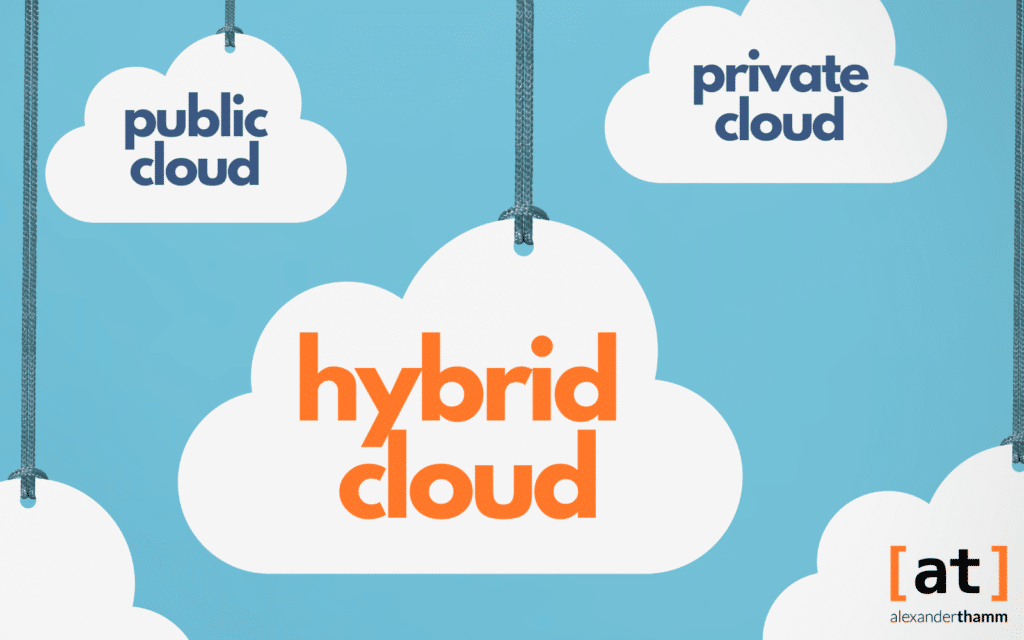The need for effective cloud management has never been more pronounced given the recent growth in cloud computing statistics. As more organisations move to the cloud, the global cloud computing market is expected to exceed $2321.1 billion by 2032, with a compound annual growth rate (CAGR) of 16 % between 2023 and 2032, according to market.us. This information shows that cloud usage is growing at an unprecedented rate, which in turn highlights the need for best practices for cloud resources and management.
Inhaltsverzeichnis
What is cloud management?
Cloud management is the Control and organisation of cloud resources, infrastructure or services. It includes the provision, monitoring, optimisation and securing of cloud resources for the efficient functioning of the digital infrastructure in a dynamic, scalable environment. This control and cloud management process works regardless of whether it is a public, private or hybrid cloud infrastructure or whether it exists in a multi-cloud environment.

Cloud computing offers numerous advantages and functions for operational processes. Read all the relevant information about this technology in our introductory article:
Challenges in managing a cloud infrastructure
Even though more and more companies are Cloud computing managing such environments is associated with various challenges. These Challenges require strategic solutions and careful considerationso that companies can master them. Therefore, organisations need to understand the challenges associated with cloud management. By doing so, they can better adapt to creative ways to overcome these challenges.
Below you will find an overview of some of the relevant challenges when managing a cloud infrastructure:
Concerns about data security and data protection
Data security and Data protection are the biggest challenges associated with cloud management. This is due to concerns about unauthorised access to Datadata breaches and compliance with industry regulations by third-party providers to whom data is entrusted. As a result, several organisations are constantly striving to improve data encryption, access controls and identity management to protect sensitive corporate data. These efforts by companies to combat concerns regarding the Data security and data protection in the cloud pose further challenges for companies that want to protect their data.
Resource allocation
Efficient resource allocation in a changing world Cloud infrastructure can be complex. This is because, depending on fluctuating workloads, most organisations struggle to optimise computing performance, storage and network resources. As a result, balancing resource allocation or cost management with meeting performance demands is a challenge that requires sophisticated management techniques and tool automation.
Continuous monitoring and compliance
If organisations are to identify and resolve potential problems in real time, continuous monitoring is essential. Companies also need to ensure that they are fully compliant with industry standards and regulations. All of this adds to the complexity and challenges associated with managing a cloud environment. However, to overcome these, organisations need to put in place powerful monitoring systems and execute and monitor practices that ensure strict adherence to compliance. However, these compliance requirements may vary for different industries and geographic regions.
Performance and reliability
Cloud services must be fast and reliable so that business processes can run smoothly. However, in times of high demand, companies can experience problems with network congestion, service outages and latency, resulting in delays in information processing. One way out is to choose a CSP with a robust system and SLAs (Service Level Agreements). In addition, redundancy measures such as disaster recovery plans and multi-region deployment can reduce the negative impact of any service outage. In this way, organisations moving to the cloud can ensure high-performance and uninterrupted cloud services and availability.
Cost optimisation and management
Although this management is designed to save companies money, it can be a challenge to manage and optimise cloud costs. If cloud resources are utilised to the maximum, usage habits are not tracked correctly and service plans are not optimised, the company may incur unexpected costs. The way out is for companies to closely monitor their resource usage, use cost optimisation tools, regularly review service plans and set up automatic scaling that is precisely tailored to their needs. In this way, costs can be reduced for the company and resources can be allocated more responsibly.
Knowledge and skills
Many organisations lack the internal expertise to manage and secure their cloud infrastructure, preventing them from taking full advantage of cloud services. They struggle to train and retrain the staff needed to optimise the cloud environment. Therefore, companies need to invest in training programmes for IT staff and work with cloud experts outside the company to overcome this challenge. Alternatively, companies can work with MSPs (Managed Service Providers) who have the right skills to leverage their proactive monitoring optimisation and problem resolution services. In this way, the burden on the organisation to manage its cloud services is greatly reduced.
Risks of vendor lock-in
If a company's dependency on a particular cloud service provider is the Migration to another platform, the company is tied to a specific provider. This challenge limits the organisation's flexibility and negotiating power. One way around this is to design architectures that are compatible with multiple cloud providers and select the company's preferred services as needed to minimise dependency.
Compliance with regulations and governance
Another challenge of cloud environmental management is ensuring compliance with industry regulations and data protection laws. These companies must ensure that their Cloud platforms comply with HIPAA, PCI DSS or GDPR regulations. This can be achieved by establishing the right access rules, data classification and encryption. In addition, regular audits and assessments are crucial to ensure compliance with industry standards and maintain customer trust.
Addressing the above challenges enables organisations to manage their cloud environment while leveraging the full potential of cloud technologies to mitigate data risks and optimise overall performance.

Cloud computing enables companies to use their IT resources more flexibly and cost-efficiently. The cloud architecture and infrastructure play a central role in this. Find out which aspects you need to pay attention to in our blog post:
Cloud Computing - Architecture & Infrastructure: Compactly explained
How cloud management works
Cloud management tools and software generally exist as virtual machines, each with its own Database and have their own server. Therefore, companies cannot fully utilise the potential of cloud management if they do not know exactly how it works. These servers use APIs to interact with the resources within a particular cloud environment. This makes it possible to capture activity in cloud-based applications and performance data that can be analysed via a web interface.
Administrators can also Access cloud management tools such as cloud resources from any locationas long as they have a secure connection. Cloud management tools enable organisations to deploy and operate cloud applications in public, hybrid or multi-cloud environments. If the existing cloud platform is 100 % efficient, it helps to track and monitor the usage and performance of any cloud infrastructure in the organisation. In this way, managers can make informed decisions about the best way to run enterprise workloads.
The management of a cloud environment comprises several interconnected Processes for provision, backup, optimisation and maintenance of cloud resources. To understand the dynamics of cloud management, it is therefore essential to analyse the general functionalities. Here is a brief summary:
- Provisioning and deploymentThis is the first part of the functional process where computing resources such as virtual machines, storage and network components are allocated according to organisational requirements. Automated tools for the rapid provisioning of resources are also essential to enable scalability and flexibility.
- Configuration and optimisationThis takes place after deployment. Proper configuration is achieved by reviewing and adjusting all functional parameters based on performance metrics to match the existing workload.
- Monitoring and performance managementThis function is comparable to configuration and optimisation. Here, cloud resources are monitored to detect problems and ensure proper performance to maintain service levels. It is a continuous process that involves tracking key performance indicators (KPIs) so that problems can be addressed immediately.
- Security measuresEnsuring adequate security measures is critical in cloud management. The overarching goal of any organisation is to protect data, so cloud management includes steps to achieve a solid security check.
- Backup and disaster recoveryOrganisations implementing cloud management environments should be able to perform data backup and recovery to improve their integrity and business continuity. The idea behind this dynamic is based on the fact that in a well-managed cloud environment, data should never really be lost, even if it appears to be. The reason for this is that data can be constantly reused, allowing for scale and elasticity.

Read our blog post to find out what challenges and added value the use of cloud computing environments entails:
Advantages and disadvantages of cloud computing for companies
Cloud management in hybrid or multi-cloud
Cloud management is becoming increasingly differentiated, as most companies are increasingly adopting hybrid or multi-cloud strategies. In these complex structures (hybrid or multi-cloud), cloud management involves the strategic use of resources in a combination of public and private clouds or multiple cloud service providers.
In a hybrid or multi-cloud environment, cloud management comprises a holistic approachin which the following aspects are taken into account:
- Interoperability
- Data consistency
- Coordination of resources
- Control
- Monitoring
Businesses therefore need to minimise complexity and optimise performance in order to reap the inherent benefits regardless of the intricacies of a hybrid or multi-cloud environment.
A hybrid cloud requires seamless integration between two or more different cloud environments. This includes delivering workloads and applications in a way that optimises performance, scalability and cost efficiency.
One fundamental aspect is the Data consistency and interoperability. Efficient cloud management in hybrid environments requires frameworks for synchronising and efficiently managing data in different cloud environments. Regardless of whether the organisation uses standardised APIs or implements extensive data synchronisation tools, maintaining the consistency, accessibility and integrity of data in a hybrid or multi-cloud environment is critical. Monitoring solutions that collect data from different cloud platforms provide a centralised overview in these complex environments. As a result, advanced analytics tools provide insights into performance, cost distribution and optimisation opportunities across the hybrid and multi-cloud environment.
While a hybrid cloud environment combines private and public cloud services, a multi-cloud model includes two or more public cloud services. The main difference between the two complex cloud environments is that hybrid cloud users own and manage a private cloud resource as part of their cloud infrastructure. This is hosted internally, in on-site data centres or on dedicated servers in third-party data centres.
What the Availability multi-cloud environments are designed for high availability compared to hybrid environments. This is because the quality of service and guarantees offered by leading cloud providers ensure that public cloud resources provide subscribed organisations with adequate business-critical uptime. If one resource fails, the company can quickly switch to another.
On the other hand, hybrid cloud resources must be managed by the owner to a certain extent. If the private resource fails, it must be maintained, which can lead to significant downtime if no backup resource is available.
Critical, regulated and sensitive data is stored well in a hybrid cloud environment. It is then connected to public resources that process less sensitive information. While it provides compliance for critical data, it is usually a limited resource where uptime and disaster recovery are problematic. However, a multi-cloud environment offers almost unlimited storage space, backups and disaster recovery capabilities, resulting in increased data security.
Companies that operate a hybrid cloud environment control who can physically access their private cloud hardware. With multi-cloud options, organisations have no control over who can access the physical infrastructure. They may need to implement robust Security layers for data backup set up. When it comes to flexibility, multi-cloud solutions have the edge. A company can choose exactly which resources it needs and select the provider with the ideal services. While most hybrid cloud users are free to choose their public cloud provider, they are more restricted when it comes to their private cloud resources.
However, the multi-cloud architecture allows companies to scale according to their needs. This is due to the fact that there is no vendor lock-in, so companies can choose the right provider for each task without being limited to a single cloud provider.
Through careful planning and execution, organisations can leverage the benefits of multi-cloud and hybrid environments while effectively addressing their inherent complexity.

Hybrid cloud solutions offer companies even more flexibility and security. Find out from us about the benefits and challenges of integrating this cloud model:
Benefits and added value of efficient cloud management
The efficient management of a cloud environment is critical to the success and effectiveness of businesses and organisations for many reasons. Below you will find a table with some reasons why efficient management of a cloud environment is crucial:
| Area | Explanation |
| Cost optimisation and savings | As cloud resources are associated with certain costs, efficient management helps to optimise these resources in order to minimise unnecessary company expenditure. In this way, companies can maximise the benefits of their cloud investments. In addition, cloud services are operated on a pay-as-you-go basis, so companies only have to pay for the resources they use, resulting in better cost savings. |
| Scalability | Cloud environments allow organisations to scale quickly in any direction (up or down) depending on their needs. Efficient cloud management therefore ensures that cloud resources are switched on and off appropriately to enable rapid adaptation to dynamic workloads. |
| Flexibility and agility | Efficient management enables companies to adapt quickly to dynamic business requirements. They can also deploy new applications and experiment with innovative solutions without major delays, ensuring better utilisation of resources. |
| Security and compliance | Efficient management is essential for maintaining a secure cloud environment. This includes the introduction and implementation of best security practices. Regular audits and compliance checks help ensure compliance with industry regulations and the protection of sensitive data. |
| Automation and Orchestration | Automation is vital to efficient cloud management and helps streamline repetitive tasks, reduce manual errors, and improve overall operational efficiency. Orchestration brings different components to work together seamlessly. |
| Cooperation and accessibility | Efficient administration provides access control and ensures that collaboration tools are utilised effectively. In this way, cloud environments can facilitate collaboration between team members and enable access to resources from any location, provided an internet connection is available. |
| Disaster recovery and business continuity | Regular backups, testing of recovery processes and mechanisms for dealing with unexpected events make for efficient cloud management. This leads to comprehensive contingency plans and ensures business continuity. |
Which cloud management strategies are suitable for data analysis and machine learning applications?
Efficient cloud management optimises Data analysis and Machine learning applications. Therefore, several strategies contribute to the effective use of cloud resources. Here are some of them:
Use of managed services
Organisations can streamline the ML workflow by using managed services from cloud providers such as Amazon SageMaker, Google AI Platform and Azure Machine Learning. This is because these services simplify infrastructure management and allow teams to focus on model development and deployment.
Data storage and management
Proper data organisation and indexing are essential for optimising data access. Therefore, companies can utilise cloud storage solutions for efficient data storage and retrieval.
Safety first and foremost
Organisations should prioritise security measures such as encryption, access controls and regular security audits. They can also implement Identity and Access Management (IAM) best practices to protect sensitive data and keep up to date with the latest security threats and technologies to adapt defences accordingly.
Cost optimisation and governance
Companies can regularly evaluate and optimise their cloud spend by using tools to track and optimise costs. Governance guidelines deploy. Implementing budget controls and exploring cost-effective solutions will help maximise cost savings without compromising performance.
Scalability planning
Companies need to develop scalable architectures that can be seamlessly adapted to different workloads. For example, they can utilise automatic scaling capabilities to dynamically adjust resources to meet demand. Thorough capacity planning to ensure that resources are in line with future growth projections is another way to drive and utilise this strategy.
Hybrid and multi-cloud strategies
Organisations can reduce the risk of vendor lock-in by using vendor-neutral tools and services. Therefore, the development and implementation of hybrid and multi-cloud environments is an effective strategy for data analytics and machine learning. It ensures better interoperability, load balancing and consistent governance policies across different cloud platforms.
Parallel processing and distributed computing
For data analytics and machine learning applications, organisations can implement distributed computing with services such as Apache Spark on EMR, Dataproc and Azure HDInsight as a strategy for parallel processing of big data analytics and ML tasks.
Automation and DevOps practices
This is another effective strategy for improving collaboration between development and operations teams. Automation benefits infrastructure provisioning, model training and deployment for faster and more reliable releases.
Serverless architectures
Most organisations can explore serverless computing as an effective strategy for certain data analytics and ML workflow components. For example, serverless platforms such as AWS Lambda, Google Cloud Functions and Azure Functions allow organisations to run in a resource-efficient manner without managing the underlying infrastructure.
Monitoring and logging
Organisations can implement robust monitoring and logging procedures with cloud-native solutions. Monitoring tools allow organisations to track application performance, detect anomalies and facilitate timely problem resolution.

Find out in our blog post how a comprehensive cloud strategy helps companies to achieve long-term goals and realise the full potential of the cloud
Cloud strategy: why companies need it and how to implement it
Scalability and flexibility for data processing
Cloud management is more than just a technical exercise. It is a strategic imperative for organisations looking to move forward in the digital space. This article has provided a detailed analysis of the concepts, challenges, dynamics and strategic applications for businesses to make informed decisions to ensure the optimal use of cloud technology for their individual organisational needs.











0 Kommentare